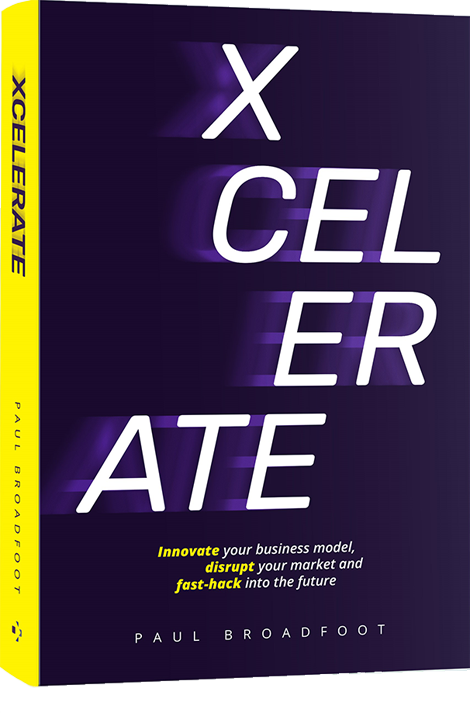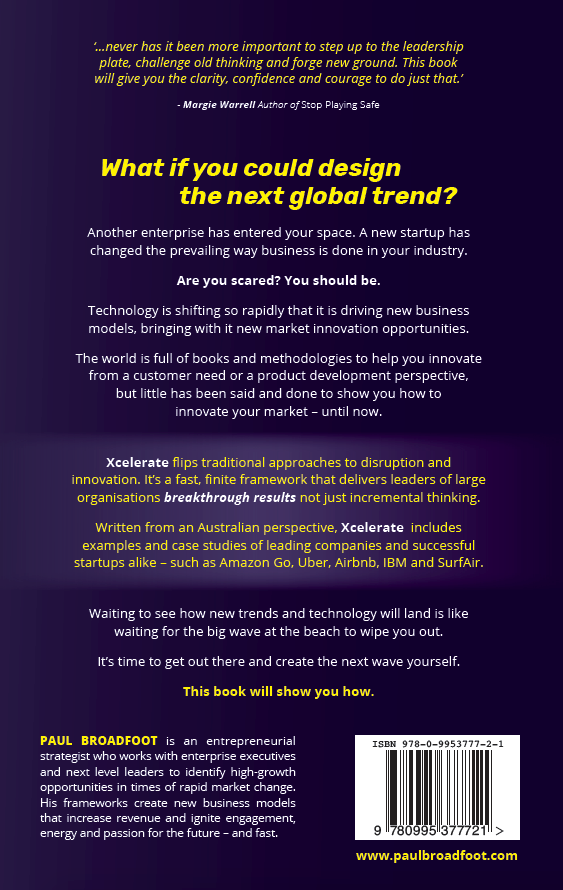Back Cover

Xcelerate –synopsis
This book is firmly set in the space of helping market incumbent organisations, and anyone in their ranks who is willing to lead a charge, to find new growth. It defines what it means to be a disruptor and an innovator and then characterises their combination into a new term Xcelerator; An outcome that both adds users to a market (addition) whilst at the same time offering existing users improved performance (switching). Whenever this has occurred, exponential growth has been the result.
Much of today’s commentary about disruption and innovation focuses on product innovation. Xcelerate contrasts product innovation with innovating the way an industry operates –market innovation. Changing the prevailing way an industry operates leads to powerful growth. Many innovation processes focus on user experience, the customer or a defined problem. In these pages another approach is offered. Without detracting from the other’s, this perspective extols identifying a company’s business model, taking a look at other business models in an industry (often all the same) and evaluating alternatives. The alternatives can be significant opportunities.
Xcelerate goes beyond just business model innovation though. In fact the ‘HOW’ part of the book (the middle third) highlights 4 parts of the Xcelerate framework –Business Model, Revenue Model, Communication Model and Differentiation Model. In each case they are represented by finite frameworks of choice. As opposed to most other types of innovation which initially diverge choice, these initially converge choice. This enables the user to very quickly locate their current way of work and then evaluate alternatives for them and/or their industry. This fast, finite framework provides a powerful hack. In this ‘HOW’ part of the book, all the models are backed up by both incumbent organisation examples like IBM, DELL and McDonalds as well as ‘startups’like Uber, Airbnb and Surf Air. Incumbents and insurgents.
There are two ‘extra’ chapters within the book –one contains Australian research commissioned for this book into over 5000 of Australia’s largest companies’ lifespans over the past 40 years. It highlights, much like data from other markets, that corporate lifespans are shrinking. The other ‘extra’ is an interview with Melanie Farmer who ran the Sussex Innovation Centre’s Innovation lab (UK) for 10 years and is now based in Australia. The latter rounds out the content of the last third of the book which gives market incumbents a process to generate, activate and launch a new business unit, a corporate venture, into either their existing business (with some highlighted risks) or into an external corporate accelerator.
Corporate innovation and business transformation initiatives within organisations are struggling and this section provides an alternate process, building from a contrast frame of incumbent vs startup.This book is offered up as a complement, and indeed a precursor to, Lean Startup Methodology. It also briefly compares the Xcelerate framework with Lean Startup Methodology, Business Model Canvas and Design Thinking. And, somewhat boldly, puts itself in the same sentence as these three impressive streams of work.Lastly, this book is a reasonable representation of its author, often quite serious and fervent about improvement but at times quite informal and irreverent. Xcelerate is intended to introduce a different, highly strategic perspective on business to readers and it is solely set out to help them navigate an increasingly fluid market landscape.

